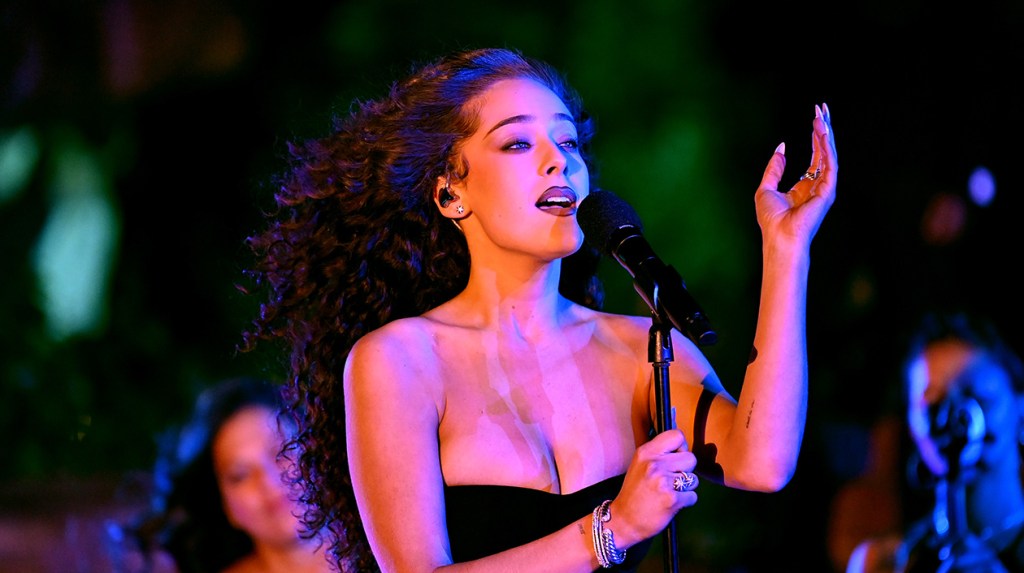In March, singer Maeta reached No. 1 on Billboard's Adult R&B Airplay chart after a persistent 35-week climb — the second-longest in the chart's history. “Through the Night” is a ballad modeled after alluring soul classics. But Maeta is 23, much younger than the veterans who often dominate the adult R&B world — singers like Charlie Wilson, with 10 No. 1 singles in the format, and Kem (8).
However, Maeta is not the only younger artist entering this territory. In the last week of March, for example, only three adult R&B singles were in the top ten of the chart. They were competing for the spot with a younger generation represented by Victoria Monet, Muni Long, Tyla, Mahalia and SZA.
Historically, adult R&B is “where you'd go to hear the music of the old acts,” he says Mike Street, Vice President of the Audacy format of mainstream hip-hop and R&B. “Then you would sprinkle in some newer acts. You're starting to have to put more of these younger, talented artists in the same space as the staples and let them pull it off.”
And “post-pandemic, younger R&B reigns supreme now,” according to Colby Tyner, programming svp for Radio One. “It's harder for some of the mainstream adult R&B artists to break through today because they're competing against SZA and Muni Long.”
Many believe that this contest has revitalized this space on the airwaves. “It seems like younger artists are reviving the form,” he says George “Geo” Cook, head of content and audience for Service Broadcasting Group, which includes Smooth R&B 105.7 in Dallas. “It's been a little stagnant just focusing on core products.”
“We believe the format should be for all R&B artists,” he adds J Valentine, who manages Tank (seven No. 1s on Adult R&B Airplay). “It shouldn't sound old.”
But as adult R&B's priorities shift, some artists may be left out in the cold. At this point, “the chart is called wrong,” he says Michael Paran, founder of P Music Group, which manages Wilson, Babyface and Jodeci among others. “Let's call it what it is: It's just R&B. The sad thing for me is the name [‘adult R&B’] it was probably the only thing that gave any kind of leverage to my acts like Charlie and Babyface. And there aren't many acts that do it at that age and actually win.”
The adult R&B format has been around for more than three decades. Tony Gray, president of Gray Communications Inc., helped launch three of those stations: V103 in Chicago in 1988, WALR in Atlanta in 1989 and WYLD in New Orleans in 1990. At the time, a younger generation of listeners was increasingly fascinated with hip -Hop or punchy fusions like the New Jack Swing. The new format “would appeal more directly to an adult audience,” says Gray.
Billboard released its Adult R&B Airplay chart in the fall of 1993. The ranking “is expected to benefit artists such as singer Phyllis Hyman and instrumentalists Grover Washington Jr. and Najee,” the magazine reported. “Record companies will now be able to create a story that can be used to gain acceptance on mainstream R&B stations and hopefully general market AC stations.” Terry RossiBillboard's director of operations said at the time.
During the streaming era, the format served as a haven for singers with golden voices like Leela James and Ledisi. But it hasn't often served as a springboard for artists to “gain acceptance” either on mainstream R&B/hip-hop stations, which tend to focus on hip-hop, or on Adult Contemporary outlets, which tend to ignore R&B altogether. Adult R&B was often “reserved for people who had no idea about the mainstream side,” he says Rex Rideouta longtime producer and songwriter and managing partner at Benchmark Entertainment.
“There was a time when there were some barriers,” Valentine acknowledges.
Because of the perception that adult R&B could be receptive but also potentially limiting for those with mainstream aspirations, younger singers could be wary of it. “Artists were saying, 'I don't want to be on the adult chart, that's making me old,'” Rideout explains.
And major labels weren't always enthusiastic about the format. “What I've been told by a lot of people on the label side is that they don't really like the R&B format because it didn't bring in streaming revenue like the mainstream side,” says Tyner. Labels usually make money from artists' streams. It's not always easy to justify paying for radio promotion with little return.
But as hip-hop became the dominant form of contemporary music, adult R&B's unwavering commitment to an underserved genre began to work in its favor. “When hip-hop became so mainstream, it pushed a lot of the R&B records to the side in the mainstream format,” he says. Jeff Robinsonwho co-manages Maeta with me Jeanine McLean. “A lot of great records weren't getting airplay there. Younger R&B artists needed a home.” And some of them—like Daniel Caesar and HER—were accepted into adult R&B.
It also helps that adult R&B stations now enjoy superior ratings over their mainstream counterparts. Radio listening is down overall, but for those who believe the airwaves still hold sway, Nielsen's top 10 stations — ranked by the percentage of radio listeners tuned in to a given station in a given market — included four different adult R&B stores in February. In comparison, there was only one mainstream R&B/Hip-Hop station in the top 50.
In this environment, it is common to see more interaction between the two forms. “There's a lot of sharing in both directions,” he says Chris Maloneprogram director of KJLH, the Los Angeles R&B station owned by Stevie Wonder.
And most importantly for adult R&B, some artists are finding that they can use it as a springboard to reach a wider audience on the airwaves. Lionel Ridenourpresident of Anchor Promotions, used this strategy last year when promoting October's London, whose “Back to Your Place” was a perfect homage to 1970s Marvin Gaye. (Maeta is now testing mainstream stations, too.)
In other words, now that more young artists are vying for airplay on adult R&B stations, the format has regained some of the power Rossi hoped it had when it launched. Adult R&B “is now a place to incubate records. has become more of an active participant in terms of breaking these acts,” Ridenour says. “When the mainstream side is so hip-hop heavy, it takes a while for an R&B record to take off. Adult R&B airplay gives you an opportunity to attract an audience and meet the mainstream market.”
One result of the sharing between formats is that adult R&B is becoming less distinct — increasingly, it's no longer the case that the format primarily offers space for artists who aren't played elsewhere. No need to play Muni Long's “Made for Me” on these stations. It has the polish and bounce of vintage hits from Brian McKnight and Mariah Carey, and an excellent vocal from Long, steely yet tender. At the same time, “Made for Me” is also on mainstream radio, prominent streaming service playlists and all over TikTok.
Paran welcomes the newcomers — they're proving that “the grown-up R&B vibe resonates with a wide audience” — but knows that radio playlist space is limited. “The last two years have been the hardest ever in terms of radio promotion,” he says. And veteran R&B singers are not welcome in other formats. While artists who soar on the Hot 100 can waltz into adult R&B if they choose, that's often a one-way street.
“I can understand why it might worry some of the older artists, as the charts are now dominated by younger people,” says Robinson. However, he remains optimistic that there is “room for everyone”.



